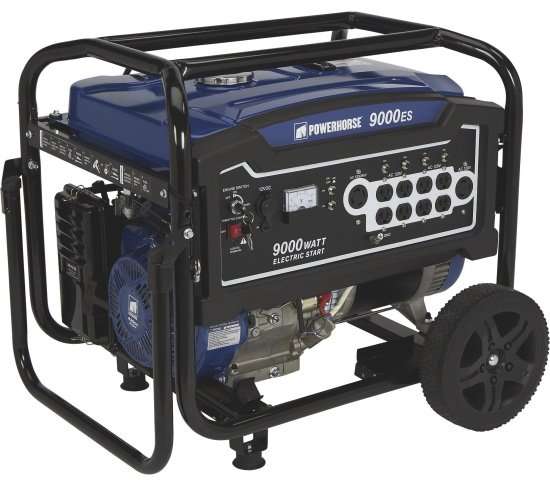Note: I get commissions for purchases made through links in this post.
Powerhorse portable generators (not to be confused with Powerhouse generators) are marketed by Northern Tool + Equipment. They offer a full line of generators ranging from 2500 watts all the way up to 13,000 watts.
Get The Powerhorse Generator While It Is Still In Stock!

If you want to skip ahead to a certain section of this review, you can click a link in the box below. Otherwise, you can just keep scrolling and reading as usual.
What Can I Use a Powerhorse Generator For?
If you’re talking about all the models in the Powerhorse line in general, you can use them for virtually any purpose. They work well for camping, tailgating, outdoor parties, etc. They can power TVs, appliances of all sizes, lights, and more.
You will especially find them useful during blackouts, storms, and natural disasters when the power grid fails in your area. Keep yourself safe and warm (or cool, depending on your latitude) and your electrical appliances and gadgets running during a power outage.
If you’re wondering about a specific model, then it depends on how many items you need to power and what size they are. As with any portable generator, not just the Powerhorse models, you need to add up the power required by everything you really need to run and pick the appropriate wattage of your generator based on that figure.
Who Makes Powerhorse Generators?
I mentioned above that Northern Tool + Equipment markets these machines, but that doesn’t mean that they manufacture them.
Northern Tool has a testing facility in Faribault, Minnesota, where they say they check out these models to “ensure optimum performance and maximum life” by putting them through “thousands of hours of rigorous testing situations”.
That can’t mean that they test every single unit before it is sold. Perhaps they spot check them to make sure that the quality standards they want are maintained.
The generators are apparently made in China. Some have said that at least some of the models might be Honda clones. (I cannot verify this claim.)
They are made with overhead valve (OHV) engines that, according to Northern Tool, are…
“built to last with industrial-strength cast iron cylinder sleeves and dual ball bearing high-performance forged crankshafts.”
They further state that a “high-end 100% copper-wound generator head allows operation at full load continuously for weeks without overheating.”
Northern Tool claims that harmonic distortion is less than 5%, so you should be able to run your more sensitive electronics without worry.
All models have a Low Oil Shutdown feature to protect the engine should the oil drop to an unsafe level.
Many of these models have an electric start, but you need to supply them with a battery as one is not normally included in the main purchase. This seems unusual to me, but it’s not unheard of elsewhere either. If your generator requires a battery, why wouldn’t you supply one that you know is going to work with the starter? (All electric start models do have a recoil backup starting mechanism.) The upside is that you can pick the brand of battery that you prefer instead of relying on whatever the company would have chosen for you.
You do get a wheel kit with the larger models. You may have to install it yourself. Not that this is a problem. I haven’t been able to find out whether or not it comes installed though.
Even though you may not be able to find the model you want at Amazon (see note above), Northern Tool says that they are always in stock through them. You may find them via other outlets as well.
If you purchase from Northern Tool and subsequently need repairs, the company says,
“Our professional in-store service department performs all repairs on site. Replacement parts are stocked at our Northern Tool + Equipment warehouse and ready to ship the same day your order is received.”
All models except the 13,000 watt have a manufacturer’s 2-year consumer and 90-day commercial warranty.
How Do the Powerhorse Models Compare to Each Other?
Take a look at the tables below to see the similarities and differences from one model to the next at a glance.
I was unable to find the decibel level for a few models. I would expect that they are in a range similar to the others nearby. Since most of these are not inverter models, they tend to be a bit noisier than other brands of equal power.
2000 to 3100 Watt Generators
| Model | 750137 | 750138 | 750139 |
| Start / Surge Watts | 2500 | 4000 | 4000 |
| Running Watts | 2000 | 3100 | 3100 |
| Starter | Recoil | Recoil | Electric / Recoil |
| Engine | DH212 | DH212 | DH212 |
| Displacement (cc) | 212 | 212 | 212 |
| Run Time* (hrs.) | 11 | 10.6 | 10.6 |
| Fuel Capacity (gal.) | 3.9 | 3.9 | 3.9 |
| Receptacles | Four 120V, 20A; one 12V DC | Eight 120V, 20A; one 120/240V 30A locking; one 12V DC | Eight 120V, 20A; one 120/240V 30A locking; one 12V DC |
| Dimensions: LxWxH (in.) | 25 ⅖ x 18 ¾ x 19 ¾ | 25 ⅖ x 18 ¾ x 19 ¾ | 25 ⅖ x 18 ¾ x 19 ¾ |
| Shipping Weight (lbs.) | 102 | 115 | 138 |
| Decibels | 67 | n/a | n/a |
*Run time is rated at ½ load
5500 to 7250 Watt Generators
| Model | 750140 | 750141 | 750142 |
| Start / Surge Watts | 7000 | 7000 | 9000 |
| Running Watts | 5500 | 5500 | 7250 |
| Starter | Recoil | Electric / Recoil | Electric / Recoil |
| Engine | DH420 | DH420 | DH420 |
| Displacement (cc) | 420 | 420 | 420 |
| Run Time* (cc) | 10.4 | 10.4 | 9.6 |
| Fuel Capactiy (gal.) | 6.6 | 6.6 | 6.6 |
| Receptacles | Eight 120V, 20A; one 120/240V 30A locking; one 12V DC | Eight 120V, 20A; one 120/240V 30A locking; one 12V DC | Eight 120V 20A; one 120V 30A locking; one 120/240V 30A; one 12V DC |
| Dimensions: LxWxH (in.) | 33 x 24 x 25 | 33 x 24 x 25 | 33 x 24 x 25 |
| Shipping Weight (lbs.) | 188 | 225 | 215 |
| Decibels | 74 | 74 | 75 |
*Run time is rated at ½ load
8400 to 10,000 Watt Generators
| Model | 750144 | 799215 |
| Start / Surge Watts | 11,000 | 13,000 |
| Running Watts | 8400 | 10,000 |
| Starter | Electric / Recoil | Electric / Recoil |
| Engine | n/a | n/a |
| Displacement (cc) | 457 | 622 |
| Run Time* (hrs.) | 8.5 | 15 |
| Fuel Capacity (gal.) | 6.6 | 12.6 |
| Receptacles | Eight 120V 20A; one 120V 30A locking; one 120/240V 35A; one 12V DC | Four 120V 20A; one 120V 30A locking; one 120/240V 30A locking; one 120/240V 41.7A; one 12V DC |
| Dimensions: LxWxH (in.) | n/a | 33 ½ x 24 ⅖ x 25 ⅗ |
| Shipping Weight (lbs.) | 209 | 324 |
| Decibels | n/a | 77 |
*Run time is rated at ½ load
You can see that most of the models have 8 standard 120V receptacles. This is many more than most other brands. So if that is a feature you need, you should seriously consider getting a Powerhorse.
What’s the Verdict on Powerhorse Portable Generators?
Based on their reviews, owners are generally satisfied with the performance and reliability of these machines. Reviews tend to be a little mixed, but the positives outweigh the negatives. There are always going to be a few units that don’t work as promised, no matter which brand you choose, and it’s easier to consider telling about problems you had than to give a glowing review when all is working fine.
Whether you get a Powerhorse or not, do get a portable generator of some sort today for your own protection and peace of mind should that day come when the power grid just isn’t working as it’s supposed to.
Click here to see the Powerhorse generators available!
And remember: It’s Powerhorse, not Powerhouse.
If you’re on the fence about buying a generator online, check out my thoughts on the matter in this article.

